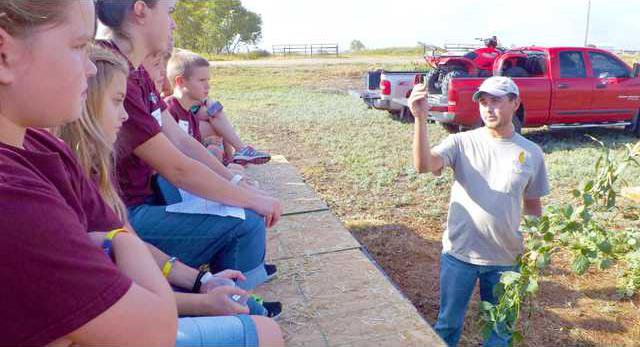From horse-drawn plows to drones, Kansas farms have evolved. Barton County fourth graders got a crash course in all things agricultural Wednesday during Kids Ag Day.
This annual event, organized by the ag committee of the Great Bend Chamber of Commerce, is always held at a real farm, where children are shown animals, machinery and crops. This year they spent their school day at the Ron Koelsch Farm west of Great Bend.
Children sat on straw bales as they listened to real farmers and ranchers talk. There were also programs by people in some of the other industries supported by agriculture.
Hay wagons pulled by tractors carried children through fields of milo and other crops. Whether they were watching someone shoe a horse or fly a drone, the children were learning how Kansas farmers feed the world.
Michael Bahr and Cole McCurry showed children several Kansas plants, and a few of the products they are found in.
“When you go home and have a snack, look at the side of the box that says ‘ingredients,’” Bahr said.
Sunflowers, the state flower of Kansas, were the only crop on display that originated in the United States. Soybeans came from China, corn is originally from Mexico, milo or sorghum is from Africa and wheat is from Russia, they said.
Jeff Seewald and Trent Mauler explained how chemicals help boost production. Mauler held up a can of Raid pest spray and asked children to guess how much a farmer might put on an acre of crops.
The low estimate was 30 gallons. “You’re way high,” he said. The answer was 4 ounces. “A little goes a long way.”
But pests and the chemicals to combat them change all of the time, he told the children. “Maybe someday one of you will be the scientist to figure out the next way to kills weeds.”
Dale Unruh, a farmer, and Doug Barrett, a sales manager at Straub International, gave a brief history of farm machinery. In the 1890s, wheat was cut with a scythe, bundled into shocks and loaded in a horse drawn wagon, then taken to a threshing machine run by a steam engine.
“A farmer would spend eight to 10 hours on every acre of ground and it would produce about 20 bushels of wheat,” Unruh said.
In the 1930s, a 25 horsepower tractor did more than 25 farm horses could do in a day, and farmers were able to produce wheat to sell as well as eat. It took three to four hours per acre to produce the same 20 bushels of what, he said.
By the 1980s, tractors were bigger and had cabs and air conditioners. Today, Barrett said, 650 horsepower tractors and other modern equipment allow farmers to work with greater speed and precision. A farmer might spend 15 minutes per acre for yields of 40-45 bushels per acre or more.
Drones were a new addition at Kids Ag Day, presented by Marty Bieker and others from Great Plans Precision Ag in Albert.
The Barton County Extension Office offered a program called “Amazing Wheat Trivia.” Extension Agent Berny Unruh showed children a bushel basket and said one bushel of wheat makes enough flour for 70 loaves of bread.
“How much does the farmer get for this bushel of wheat?” she asked.
Most children guessed much higher than the current price of around $4.
Kansas is called the Wheat State, children were reminded.
“Kansas farmers, American farmers, actually help feed the world,” Unruh said.
FEEDING THE WORLD
Fourth graders attend Kids Ag Day





